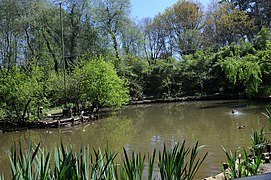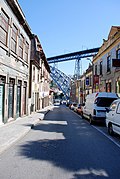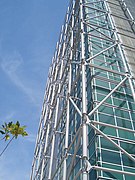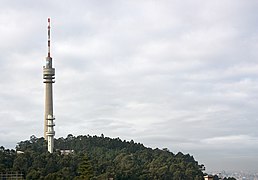Vila Nova de Gaia
Vila Nova de Gaia | |
|---|---|
|
UTC±00:00 (WET) | |
| • Summer (DST) | UTC+01:00 (WEST) |
| Website | www |
Vila Nova de Gaia (Portuguese pronunciation:
The city contains many cellars (locally known as "caves") where port wine is stored and aged. These cellars have become a major tourist attraction.
History

Vila Nova de Gaia already existed under the
With the Moorish invasions in the eighth century, the de facto frontier between the Islamic state and the Christian one came to rest for a considerable period of time on the river Douro. With the constant raids and counter-raids, the town of Cale, or Gaia, was deserted and most of its inhabitants took refuge in Porto in the North side of the river. It is in this period, the tenth century, that the late medieval Lenda de Gaia (Legend of Gaia) is set.
After the conquest and pacification of the southern side of the Douro river after 1035, with the exodus or expulsion of the Muslim populations, leaving behind semi-abandoned fertile lands, colonists from the north settled in exchange for better
The name of the double city of Porto and Gaia was frequently referred to in contemporary documents as "villa de
Parishes
Administratively, the municipality is divided into 15 civil parishes (
| Parish | Population[8] | Area (km²)[2] |
|---|---|---|
| Arcozelo | 14,352 | 8.50 |
| Avintes | 11,497 | 8.82 |
Canelas |
13,459 | 6.90 |
Canidelo |
27,769 | 8.93 |
| Grijó e Sermonde | 11,938 | 12.99 |
| Gulpilhares e Valadares | 22,019 | 10.61 |
Madalena |
10,040 | 4.69 |
| Mafamude e Vilar do Paraíso | 52,422 | 10.58 |
Oliveira do Douro |
22,383 | 7.54 |
| Pedroso e Seixezelo | 20,426 | 20.88 |
| Sandim, Olival, Lever e Crestuma | 17,168 | 34.16 |
| Santa Marinha e São Pedro da Afurada | 33,714 | 6.91 |
| São Félix da Marinha | 12,706 | 7.93 |
| Serzedo e Perosinho | 14,250 | 11.97 |
| Vilar de Andorinho | 18,155 | 7.07 |
The parish Santa Marinha e São Pedro da Afurada contains the city centre of Vila Nova de Gaia.
Coat of arms and flag
The coat of arms consists of a grey crest with two golden-yellow bunches of grapes on the bottom with a black castle over the water, and with a person blowing the horn. The grapes intend to represent the city's connection with the wine industry, mainly Port wine, whose cellars are in the lower part of the city.
The flag features the coat of arms on a field of eight wedges (
Leisure
Beaches
Vila Nova de Gaia is the Portuguese municipality with the highest number of
Parks and gardens
- Gaia Biological Park (Portuguese: Parque Biológico de Gaia) is the largest park in the city, with an area of 35 hectares. The Park established in 1983 as an environmental education center, features a 3 km walkway along with hundreds of species of animals and plants.[11][12][13]
- Opened in August 2005, the Lavandeira Park (Portuguese: Parque da Lavandeira) is a place for leisure activities with a lake, pedestrian walks, picnic areas and theme gardens. It has an area of 11 hectares located in Oliveira do Douro.[14][15][16][17][18]
- Jardim do Morro ("Garden of the Hill") is a garden located in the parish of Santa Marinha, near the Sera do Pilar Monastery. It was established in 1927. There is a lake, a number of plant species including Tilias.[19]
- The Littoral Station of Aguda (Portuguese: Estação Litoral da Aguda) is a show aquarium opened in 1999 on the beach of Aguda (Portuguese: Praia da Aguda) in Arcozelo. The building designed by the architect João Paulo Peixoto includes 3 main sections: Fisheries Museum displaying fishery equipment; Aquarius demonstrating local aquatic fauna and flora, and the Department of Environmental Education and Scientific Research on marine ecology, fishery and aquaculture.[20][21][22]
- Local Nature Reserve of the Douro Estuary (seagulls, kingfishers among many other birds throughout a year. São Paio Bay is a popular spot for bird watchers.[18][23]
There are also Dunes Park (Portuguese: Parque de Dunas), Botanical Park of Castelo (Portuguese: Parque Botânico do Castelo), Camelias Garden (Portuguese: Jardim das Camélias), Streams of Gaia (Portuguese: Ribeiras de Gaia), Maria Pia Bridge Park (Portuguese: Parque Ponte Maria Pia) in Vila Nova de Gaia.[18]
-
Gaia Biological Park
-
Jardim do Morro
-
Nature Reserve of the Douro Estuary
Tourism
Museums


House-Museum Teixeira Lopes| Diogo de Macedo Gallery (Portuguese: Casa-Museu Teixeira Lopes| Galerias Diogo de Macedo) is a cultural center consisting of the house of the sculptor António Teixeira Lopes and recently built Diogo de Macedo Galleries located in Vila Nova de Gaia. The building of the museum was constructed in 1895 by António Teixeira Lopes and his brother José Teixeira Lopes as a residence and an atelier. The Master donated this property to the municipality of Vila Nova de Gaia, and it was opened to the public as a house-museum in 1933. Diogo de Macedo Gallery was established in 1975 in a building annexed to Teixeira Lopes' atelier. The Art Galleries in the House-museum demonstrates works of Portuguese painters and sculptors, as well as pieces of pottery factories of Gaia, while Diogo de Macedo Galleries display the sculptural works of Diogo de Macedo and his art collection consisting of decorative art examples from 16th-20th centuries.[24][25]
Solar dos Condes de Resende is a former manorial property which is now the headquarter of the Municipal House of Culture located in the village of
Gallery
-
Apartment buildings in the parish of Mafamude
-
Beach in Miramar
-
Metro next to El Corte Inglés
-
Soares dos Reis Square
-
Gaia at night
-
Gaia
-
Vila Nova de Gaia
-
Tower Plaza Regino, Gaia
-
Vila Nova de Gaia
-
Downtown Gaia
-
Vila Nova de Gaia
-
Vila Nova de Gaia TV Tower
-
Littoral Station of Aguda
-
Vila Nova de Gaia
-
Porto Urban Area
-
Vila Nova de Gaia
-
Gaia
Sister City
Vila Nova de Gaia is
![]() Concord, Massachusetts, United States of America
Concord, Massachusetts, United States of America
![]() Dunavarsány, Hungary
Dunavarsány, Hungary
Notable people



- Maria Isabel Wittenhall van Zeller (1749–1819), a pioneer in the use of vaccination against smallpox.
- António Soares dos Reis (1847-1889), a Portuguese sculptor.
- António Teixeira Lopes (1866–1942), a Portuguese sculptor.
- Daniel Pina Cabral (1924–2008), an Anglican bishop, Bishop of Lebombo, Mozambique, 1968 to 1976
- António Pires Veloso (1926–2014), an Army General, overseas Governor & political candidate
- António Reis (1927–1991), a film director, screenwriter and producer, poet, sculptor and ethnographer.[28]
- Maria Alberta Menéres (1930–2019), a Portuguese author, children's writer, journalist and poet.
- Bruce Duncan Guimaraens (1935–2002), a Portuguese-British port wine maker.
- António Pinho Vargas (born 1951), a jazz and contemporary music composer and pianist
- Paulo Rangel (born 1968), a Portuguese jurist, politician and MEP since 2009.
- Dalila Carmo (born 1974), a Portuguese actress.[29]
- Sónia Rocha (born ca.1975), a cell biologist and academic at University of Liverpool
Sport
- João Pinto (born 1961), a retired footballer with 408 club caps and 70 for Portugal.
- José Tavares (born 1966), a retired footballer with 294 club caps and 8 for Portugal.
- Vítor Baía (born 1969), a retired football goalkeeper with 447 club caps and 80 for Portugal.
- Basílio Almeida (born 1971), a footballer with 499 club caps
- António Folha (born 1971), a footballer with 337 club caps and 26 for Portugal & current manager.
- Rui Jorge (born 1973), a retired footballer with 324 club caps and 45 for Portugal.
- Fernando Jorge Tavares de Oliveira (born 1975), known as Bock, a retired footballer with 635 club caps
- Artur Soares Dias (born 1979), a football referee with FIFA & UEFA since 2010.
- Ricardo Costa (born 1981), a footballer with 458 club caps and 22 for Portugal.
- Lenine Cunha (born 1982) a Paralympic athlete, competed in the 2000 Summer Paralympics
- Luís Monteiro (born 1983), a former free-style swimmer, competed at the 2004 Summer Olympics
- Bruno Vale (born 1983), a retired football goalkeeper with 476 club caps and one for Portugal.
- Vanessa Fernandes (born 1985), a triathlete and silver medallist at the 2008 Summer Olympics
- André Gomes (born 1993), with over 200 club caps and 29 for Portugal.
- Ivo Oliveira & Rui Oliveira (twins, born 1996), Portuguese racing cyclists
References
- ^ Uma População que se urbaniza, Uma avaliação recente - Cidades, 2004 Archived October 6, 2014, at the Wayback Machine Nuno Pires Soares, Instituto Geográfico Português (Geographic Institute of Portugal)
- ^ a b "Áreas das freguesias, concelhos, distritos e país". Archived from the original on 2018-11-05. Retrieved 2018-11-05.
- ^ Instituto Nacional de Estatística
- ^ "Am Faclair Beag - Scottish Gaelic Dictionary".
- ISBN 978-90-04-17336-1, pages 107-108
- ^ ^ Wodtko, Dagmar S.; Irslinger, Britta; Schneider, Carolin (2008), "*dʰeu̯b-", in Nomina im indogermanischen Lexikon [Nouns in the Indo-European Lexicon] (in German), Heidelberg: Universitätsverlag Winter, pages 122-124
- ^ Diário da República. "Law nr. 11-A/2013, pages 552 134-135" (PDF) (in Portuguese). Retrieved 4 August 2014.
- ^ Instituto Nacional de Estatística (INE), Census 2011 results according to the 2013 administrative division of Portugal
- ^ "Praias". www.cm-gaia.pt (in Portuguese). Retrieved 2019-01-25.
- ^ "Próxima paragem? Praia da Granja". PÚBLICO (in Portuguese). Retrieved 2019-01-25.
- ^ "Parque Biologico de Gaia". www.parquebiologico.pt. Retrieved 2019-01-25.
- ^ "Parque Biologico de Gaia - Evolution". www.parquebiologico.pt. Retrieved 2019-01-25.
- ^ "Parque Biológico de Gaia: 30 anos de proteção ambiental - JPN". JPN - JornalismoPortoNet (in European Portuguese). Retrieved 2019-01-25.
- ^ "Parque da Lavandeira". www.parquebiologico.pt. Retrieved 2019-01-25.
- ^ Manha, Correio da. "Gaia vai ampliar parque da Lavandeira e reabilitar estufa do século XIX". www.cmjornal.pt (in European Portuguese). Retrieved 2019-01-25.
- ^ Gaia, Câmara Municipal de. "Parque da Cidade - Espaços ao ar livre - Desporto - Cidade - Câmara Municipal de Gaia". www.cm-gaia.pt (in Portuguese). Retrieved 2019-01-25.
- ^ "Parque da Lavandeira - O que fazer". www.portoenorte.pt. Retrieved 2019-01-25.
- ^ a b c "Parques". www.cm-gaia.pt (in Portuguese). Retrieved 2019-01-25.
- ^ Carla Sofia Luz. "Jardim do Morro será recuperado no verão". Jornal de Notícias. Retrieved 2019-01-25.
- ^ "ELA - Littoral Station of Aguda". www.fundacao-ela.pt. Retrieved 2019-01-25.
- ^ "ELA - History". www.fundacao-ela.pt. Retrieved 2019-01-25.
- ^ "Estação Litoral da Aguda". www.cm-gaia.pt (in Portuguese). Retrieved 2019-01-25.
- ^ "Reserva Natural Local do Estuário do Douro - Qué hacer". www.portoenorte.pt. Retrieved 2019-01-25.
- ^ "House-Museum of Teixeira Lopes". www.cm-gaia.pt (in Portuguese). Retrieved 2019-01-31.
- ^ "Casa-Museu Teixeira Lopes". www.patrimoniocultural.gov.pt. Retrieved 2019-01-31.
- ^ "Solar Condes de Resende". www.monumentos.gov.pt. Retrieved 2019-01-31.
- ^ "Solar Condes de Resende". www.cm-gaia.pt (in Portuguese). Retrieved 2019-01-31.
- ^ António Reis, IMDb Database.
- ^ Dalila Carmo, IMDb Database.
External links
- Photos from Vila Nova de Gaia
- Gaia Extra - Local news site about Vila Nova de Gaia
- Gaia The Magic City - Local Social Network
- Dra. Ana Sousa - Clinica de Medicina Estética em Gaia































